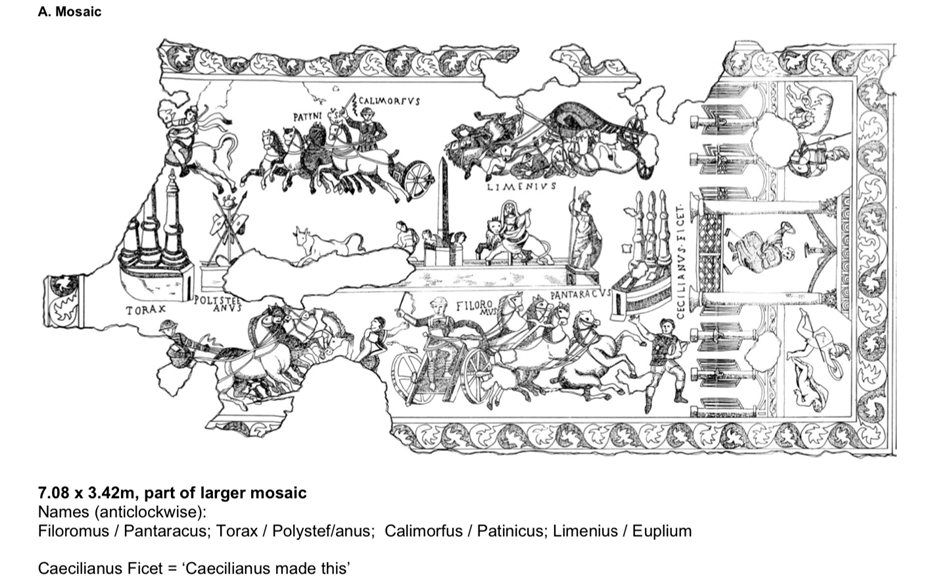Introduction
Roman emperors had an interesting strategy for entertaining their masses. Particularly, they gave the people cheap bread and organized frequent gladiatorial game contests to distract them from their political failures. The technique was effective as people started focusing on the bread and circuses while ignoring the more pertinent issues of governance. The image excerpt (figure 1) gives a glimpse of the practices that guided the daily lives of people in ancient. The image (arena for chariot racing) is typical of those made during the ancient Roman circuses. Although the image shows many activities, the focus is on the wild and violent horse race games, which were a central social activity at the time.

Context and Historical Information
The artwork is an arena used for chariot races and contests of the Ancient Roman Empire, the name of the commissioner is unknown. The image shows only what survived of the arena after the collapse of the Roman empire and the end of the games. Although it is only excerpts, its value is preserving the structure, decors, and other elements of the arena. However, there are better-preserved arenas such as the circus in Libya. The geographical context of the Greeks is that they boarded Spain in the west, Ukraine in the North, Egypt in the south, and Afghanistan in the East. Expectedly, some interactions led to the copying of culture. For instance, mosaics had a long history in Egypt and Mesopotamia before artists popularised them in Rome.
Notably, sports in Rome were associated with significant commercial activities such as sports gambling, tourism accommodation, professional athletes, food vendors, and other petty business vendors. The implication is that there were often interactions with people from foreign countries who came for entertainment while bringing their merchants. The horses were important animals in the games, which also provided a means of transportation among the people. The emperors made the Colosseum with layouts that permitted them to structure the society in a way that made it easy for the state to control the masses. In addition, the gladiatorial contests legitimized the powers of the emperor to the senate and the people.
Close Analysis of the Image
The focal point of the mosaic is arguably around the place that Limenius is riding. On his immediate left is a sword-like monument with two people tied underneath. The far left from this central point has two arrows and bows placed upright, and the furthest left shows the top section of a building with three-pointers. The kind of games the people loved was full of aggression and even oppression. Notably, wars were a common phenomenon in the region, making sense for them to be replicated in sports.
The spectacular buildings at the arena in the mosaic indicate the peculiarity of the Romans. The structure was made to offer maximum visibility for the audience. It is large and raised so that all people could easily view what was going on at the arena. The buildings have a canonical representation to show commitment to religiosity. Notably, with interactions, circuses were later established in regions such as North Africa, which later became relevant and famous for horse racing. For instance, the Lepcis Magna is one of the best preserved and fully published Roman circuses in Libya. It is structured with decorations architectural finishing similar to the Circus Maximus.
The other captivating aspect of the mosaic is the horses and their riders (especially their names). The horse riders include Torax, Polystef anus, Floro, and Patinicus. The mosaic’s central theme is the horse race, which can be an aggressive game where people get injured. Names are significant in portraying identity, and in this case, they show that most of the contestants show that they were from Rome. Notably, there are a set of four horses with contestants riding together followed by a similar set, indicating a pattern that is similar to a stipple chase. While in the circus, the audience had their favorite contestant. The implication is that each person had to showcase their prowess and skills in riding the horses regardless of their potential exposure.
Specific patterns in this mosaic can help viewers understand the culture and the games presented at the arena. From the right, there is a gate opening marked with two strong poles, distinct from the other smaller demarcations of the building, which served as a barrier separating the players, audience, and emperors. There are decorations at the edge of the mosaic which appear like curved leaves with an alternate white and black color. The significance of this evidence is that it aids in understanding the communities that the Romans interacted with during the games. Other symbolic decorations like the one in the lower right corner where a woman is lying down and a man are aggressively lifting something as though to drop on her represent the cultural gender role.
The horse races were an essential activity in ancient Rome as they kept the citizens entertained while distracting them from seeing the political failures. The mosaic shows how a typical arena for violent horse races was organized. The mosaic links to the broad theme of the development of games and sports as it represents the venue for holding the events. The games were good but eventually exposed the vanity of failed leadership structure, and the horse races moved to other regions like North Africa.
Reference List
Castro, F. (2021) ‘The significance of the Colosseum to ancient Rome’, Teaching History, 55(2), pp.10-17.
Humphrey, J. H. (1986) Roman Circuses: Arenas for Chariot Racing. Berkeley and Los Angeles: University of California Press.
Vamplew, W., (2022) ‘Bread and Circuses, Olive Oil and Money: Commercialized Sport in Ancient Greece and Rome’, The International Journal of the History of Sport, 35(1), pp.1-20.